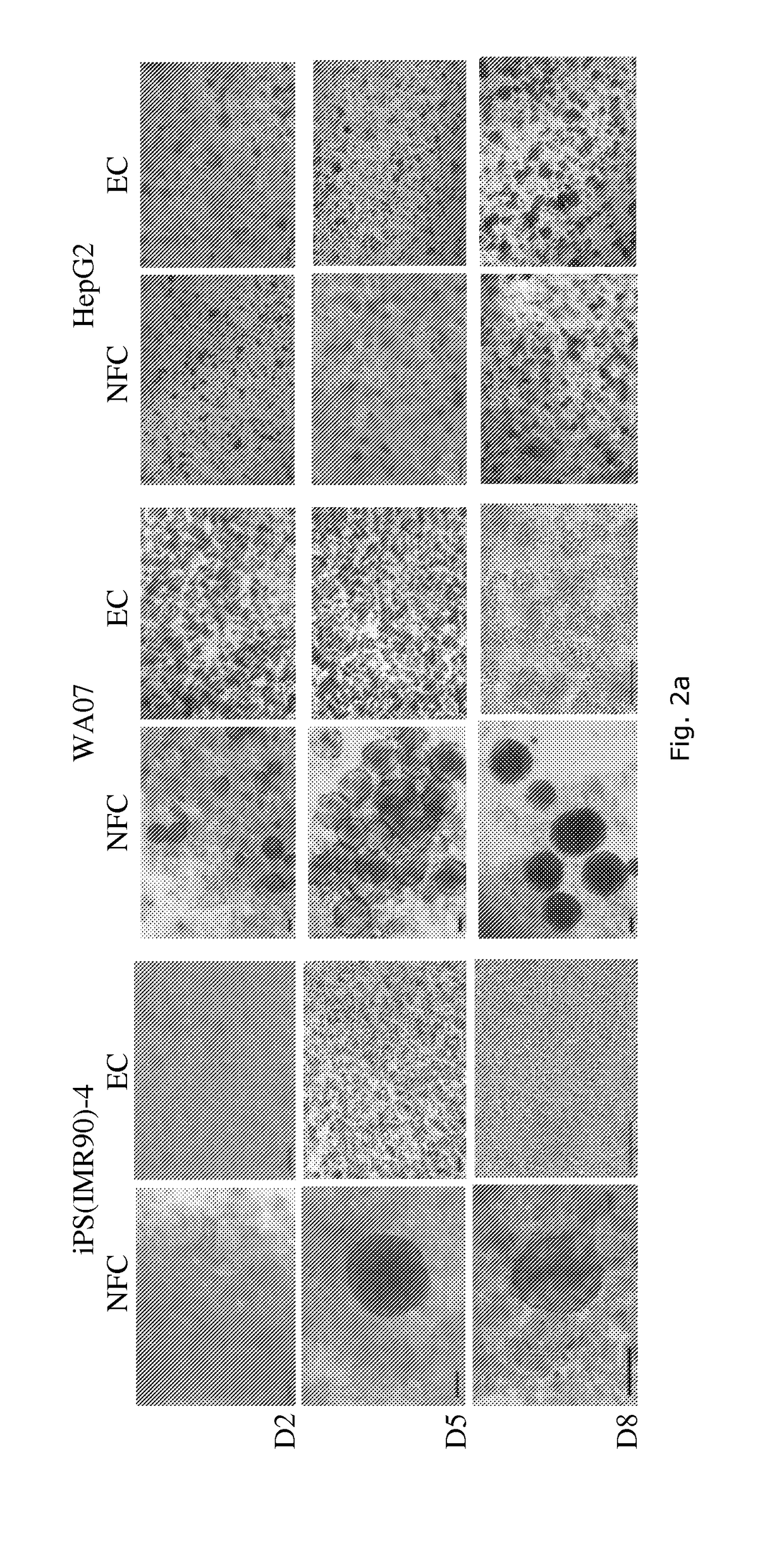Chemical testing
a chemical testing and method technology, applied in the field of chemical testing methods, can solve the problems of difficult prediction of drug distribution to individual cell types or tissues in humans, animal experiments may not mirror human, and human translation may be impossible or feasible, and achieve the effect of high beneficial culturing
- Summary
- Abstract
- Description
- Claims
- Application Information
AI Technical Summary
Benefits of technology
Problems solved by technology
Method used
Image
Examples
example 1
[0151]Formation of 3D Stem Cell Spheroids in NFC Hydrogel
[0152]Cells used for this study were human embryonic stem cell line WA07 with normal karyotype and blood type B (WiCell). Cells were cultured in aseptic conditions without antibiotics and incubated in HERACell® 150 CO2 incubator (Kendro laboratory) at 37° C. in 5% CO2.
[0153]Cells were thawed and seeded to the 2D conditions on Matrigel (BD Biosciences®; 356230) coated 6-well plate (Sarstedt; 83.1839). Matrigel coating was made at room temperature by adding cold DMEM / F-12 medium (Gibco®; 31330) to the cold Matrigel solution and incubating for one hour at room temperature. A feeder-free and serum-free stem cell culture medium mTeSR1™ basal medium (Stem Cell Technologies; 05851) supplemented with 5x mTeSR™ 1 (Stem Cell Technologies; 05852) was changed daily. Approximately on day four cells when the cell confluency was 60-80% they were passaged into a new Matrigel coated 6-well plate using a splitting ratio of 1:4 to 1:6. The detac...
example 2
[0159]Studying the Impact of Activin A on in Vivo like Cells Obtained by Culturing in Plant-Derived NFC Hydrogel
[0160]In short stem cells were cultured in NFC hydrogel to obtain 3D spheroids, which were released from the NFC hydrogel by enzymatic digestion. Then the 3D spheroids were washed and seeded into another NFC hydrogel, and a test chemical, here growth factor Activin A, was added and the 3D spheroid cultures were incubated. After incubation, the impact of the test chemical on spheroid morphology was detected before removing the second NFC hydrogel, while other detections were conducted after removing the NFC hydrogel.
[0161]Exposing 3D Stem Cell Spheroids to Test Chemical Growth Factor Activin A for Inducing Formation of Definitive Endoderms
[0162]After growing stem cell spheroids and removing them from NFC hydrogel according to Example 1, spheroids were first washed once with RPMI-1640 basal medium (Table 1) supplemented with GlutaMax™ (Table 2). Next spheroids were resuspend...
example 3
[0163]Studying the Impact of a Combination of Differentiating Agents on in Vivo like Cells Obtained by Culturing in Plant-Derived NFC Hydrogel
[0164]Another experiment started with new thawed WA07 cells. The cells were passaged twice on 2D environment and then grown to stem cell spheroids as described in Example 1. After cellulase treatment spheroids were differentiated into DE cells similarly to the previous experiment, this time only with 0.5% NFC hydrogel concentration and for six days. After releasing cells from NFC with cellulase, the experiment continued by the differentiation of DE cells into hepatic progenitor (HP) cells in the same 96 well plate. NFC hydrogel concentrations tested at this differentiation step were 0.5%, 0.75%, and 1.0%. NFC dilutions were made by diluting NFC stock with M2 medium. Differentiation medium (M2) consists of HBM™ basal medium supplemented with suitable HCM™ SingleQuots (Table 2), BMP2, BMP4 and FGF4 (Table 3). Double concentrated M2 medium was re...
PUM
| Property | Measurement | Unit |
|---|---|---|
| wt % | aaaaa | aaaaa |
| diameter | aaaaa | aaaaa |
| length | aaaaa | aaaaa |
Abstract
Description
Claims
Application Information
 Login to View More
Login to View More - R&D
- Intellectual Property
- Life Sciences
- Materials
- Tech Scout
- Unparalleled Data Quality
- Higher Quality Content
- 60% Fewer Hallucinations
Browse by: Latest US Patents, China's latest patents, Technical Efficacy Thesaurus, Application Domain, Technology Topic, Popular Technical Reports.
© 2025 PatSnap. All rights reserved.Legal|Privacy policy|Modern Slavery Act Transparency Statement|Sitemap|About US| Contact US: help@patsnap.com



